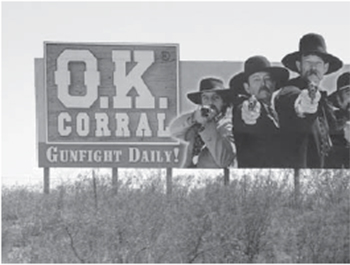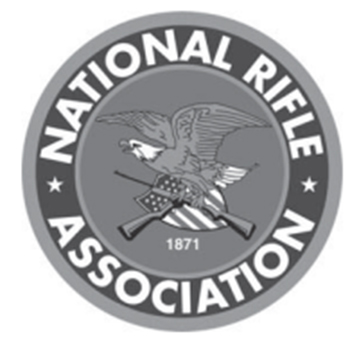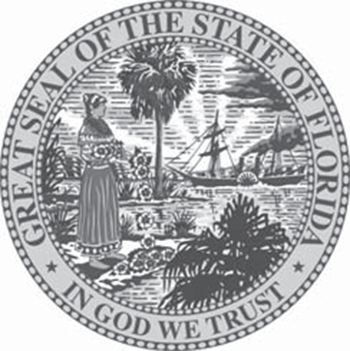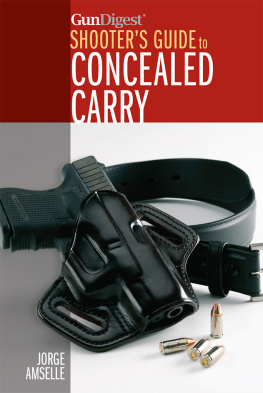Gun Digest
SHOOTERS GUIDE to
CONCEALED CARRY
JORGE
AMSELLE
CONTENTS
CHAPTER 1
HISTORY OF CONCEALED CARRY

A police raid confiscating illegal alcohol during the 1920s. Many firearms prohibitions and controls date to the same time period. loc.gov
PROHIBITION
Throughout most of Americas history, firearms were commonplace, used by hunters, farmers, target shooters and law enforcement and military personnel. The sight of someone carrying a gun would rarely raise an eyebrow, and no one felt any need to conceal their firearmsunless they had a nefarious purpose.
Highwaymen, road agents and footpads were a constant danger to the traveler and would often conceal their weapons to gain the advantage of surprise against their unsuspecting victims. No decent person, it was thought, had any cause to conceal a weapon on his or her person. In fact, states and local jurisdictions enacted laws and ordinances outlawing the concealment of weapons during the early 1800s.

During the 1880s, Western towns such as Tombstone, Arizona, had problems with young, drunk, single, armed cowboys. Now its a tourist attraction. Nick Ares
In rural areas, openly carrying firearms was common, but in more populated areas, especially where problems had previously occurred, firearms regulations were enacted and enforced. One of the most well known examples took place in 1881 in Tombstone, Arizona Territory. Local ordinance outlawed the carrying of firearms in town, whether concealed or open, and an attempt to disarm some cowboys ended up as the famed gunfight at the OK Corral.
In 1911, New York passed the Sullivan Act, making it the first state to aggressively regulate firearms. It mandated that anyone seeking to own a concealable handgun had to first obtain a permit. And carrying a concealable firearm was further regulated. But as far as rifles were concerned, it was not uncommon to see someone on public transportation well into the 1950s and 1960s with a cased rifle on their way to hunt or target shoot, even in New York City.
FEDERAL LAWS
Of course the history of concealed carry is inexorably intertwined with the history of gun control in general. The Second Amendment to the Constitution, protecting the right to keep and bear arms, was not initially involved because the federal government had not taken any steps to restrict firearms; laws that did so were left up to the states. That changed in 1934 with the passage of the National Firearms Act, which implemented restrictions on machine guns, sawed-off shotguns and various other uncommon firearms.
The Gun Control Act of 1968, enacted following several high-profile political assassinations, came next and resulted in most of the modern restrictions we have today. It created a list of people prohibited from gun ownership (felons, drug users, etc.). It established the licensing of firearms dealers and restricted the ability of private persons to buy guns directly. It also implemented importation restrictions on non-sporting firearms.

The National Rifle Association was established in 1871 to promote marksmanship. Its Americas longest-standing civil rights organization, dedicated to protecting Second Amendment rights. Fair use logo image of NRA
It was after this point that the National Rifle Association (NRA), founded in 1871 to promote marksmanship, decided to become politically active. In 1975, the NRA established the Institute for Legislative Action (NRA-ILA) to lobby on behalf of gun rights. However, it took more than 10 years to achieve its first victory, with the 1986 Firearm Owners Protection Act. This act established protections for federally licensed firearms dealers from abusive regulations and oversight. It protected the rights of people traveling with firearms across state lines. It prohibited the federal government from maintaining a national registry of firearms. Finally, it also prohibited the registration of any new machine guns, freezing the supply of legally transferable machine guns.
The two most significant federal firearms laws after this were the 1993 Brady Handgun Violence Prevention Act, which mandated background checks for all firearms purchases from licensed dealers, and the 1994 Assault Weapons Ban, which sunset in 2004 and is no longer applicable. It should be noted that there was a huge backlash after the 1994 Assault Weapon Ban, which directly contributed to unprecedented losses for the Democrat Party in Congress and the Republican takeover of the House of Representatives for the first time in nearly 40 years. President Bill Clinton acknowledged that the gun issue had caused irreparable harm to his party, and most politicians have been smart enough to stay away from promoting gun bans ever since. It is also why the law was allowed to die in 2004.
TURNING POINT
The mid-1980s marked the beginning of a new era for gun rights. At this time, according to NRA-ILA, only 10 states had laws that made it fairly easy for the average person to carry a concealed firearm. Then in 1987, Florida enacted a shall issue law, which basically stated that any law-abiding individual had the right to receive a concealed-handgun permit.
The media went nuts, ignoring the fact that 10 other states had already initiated similar laws. Newspaper headlines declared that there would be shoot-outs in the street, just like during the Old West days. There was even a made-for-TV movie about it called Right of the People, which aired during prime time on ABC (since there were only three major networks back then, prime time airing was a big deal) and starred Lando Calrissian (Billy Dee Williams).

In 1987, Florida granted any law-abiding resident the right to receive a concealed-handgun permit. Public domain
The film was sensationalist claptrap and anti-gun propaganda. If you ever need a good laugh and have a couple of hours of your life to waste, try to find a copy. The basic storyline is that after a horrible crime, the residents of a small town decide to allow anyone who wants to carry a gun to do so. Hilarity ensues when a bunch of trigger-happy morons (which is how the media routinely portrays gun owners) get into enough shootouts that the new law is reconsidered.
SHALL ISSUE VS. MAY ISSUE
Currently all 50 states have laws that provide for residents to apply for a permit to carry a concealed handgun. In the vast majority of the states, the law stipulates that the issuing authority (the state or local police, local sheriff or judges) has no discretion. They must issue concealed-handgun permits to all applicants who meet the standards set by the state. Applicants do not have to provide a reason for carrying, or if they do, self-defense is accepted without question. This is known as shall-issue.
In a small handful of states (currently eight of them), the issuance of concealed-carry licenses is left to the arbitrary discretion of the issuing authority. These are known as may-issue states. In those places where the state police are in charge of permits, theres at least some uniformity and guidelines that residents can clearly learn and follow. In Maryland, for example, the state police issue permits. And while it is extremely difficult to get one and applicants must show a compelling reason, at least the system is transparent and uniformly applied.















